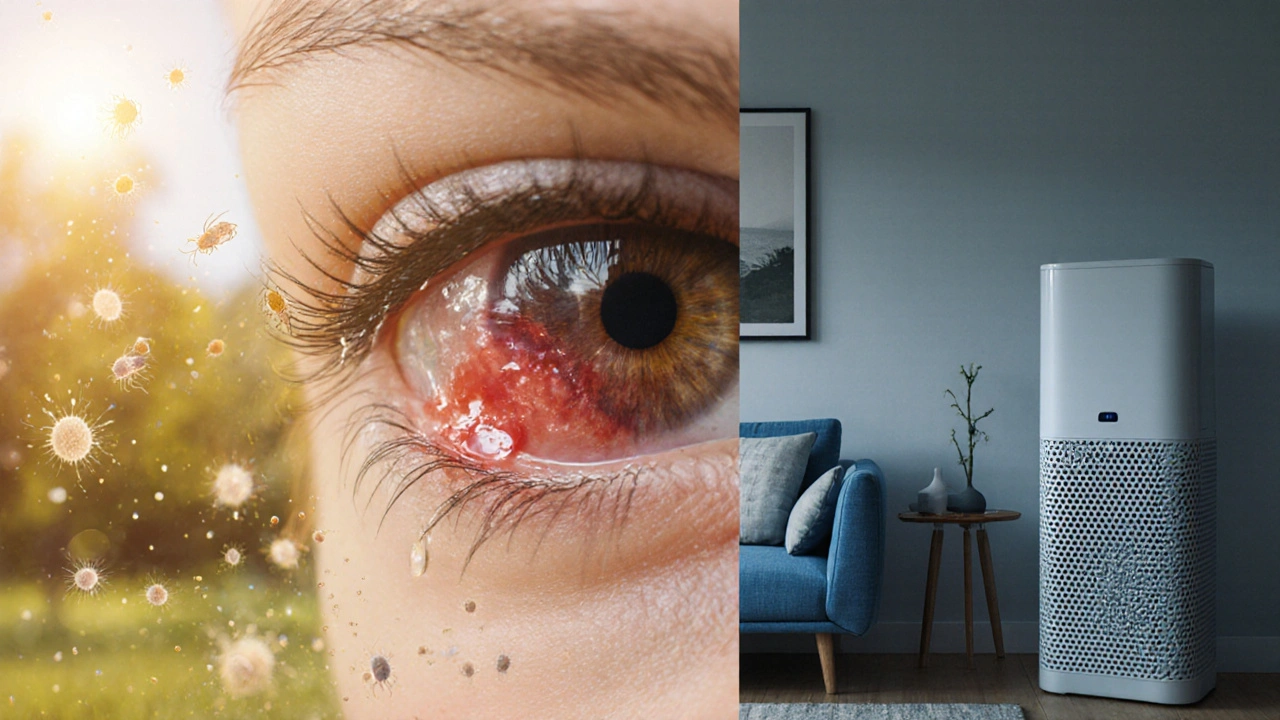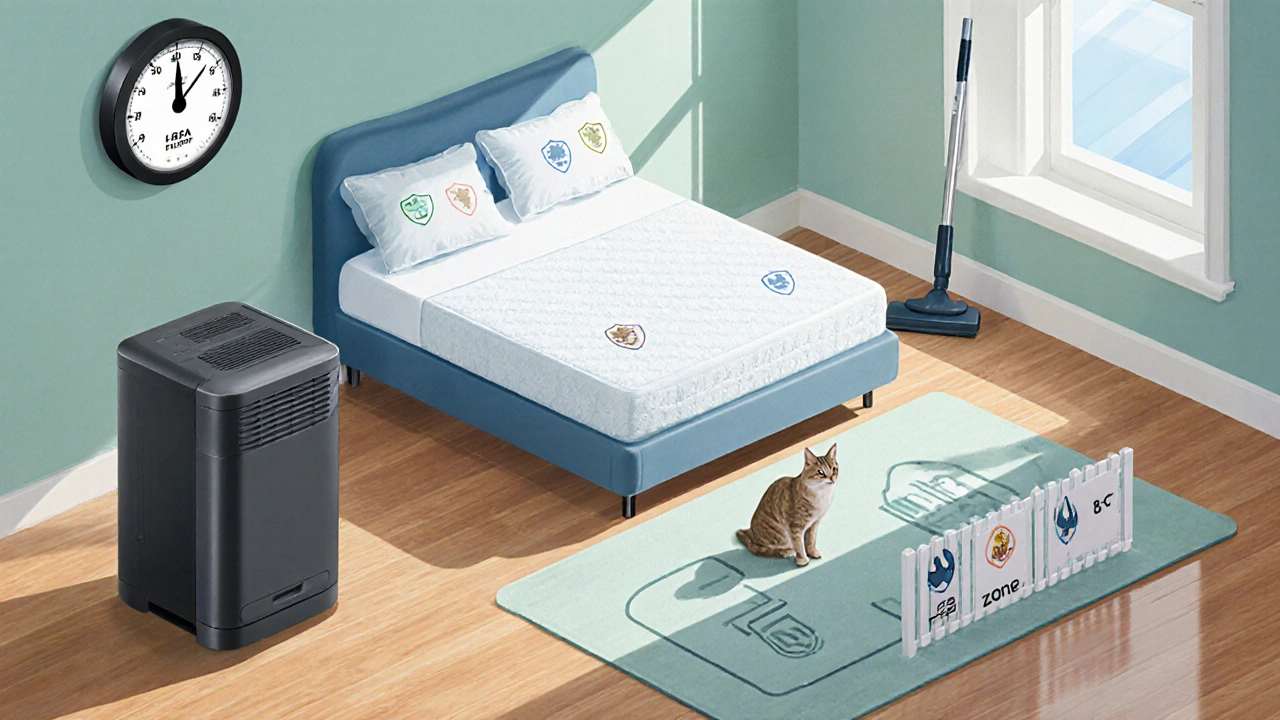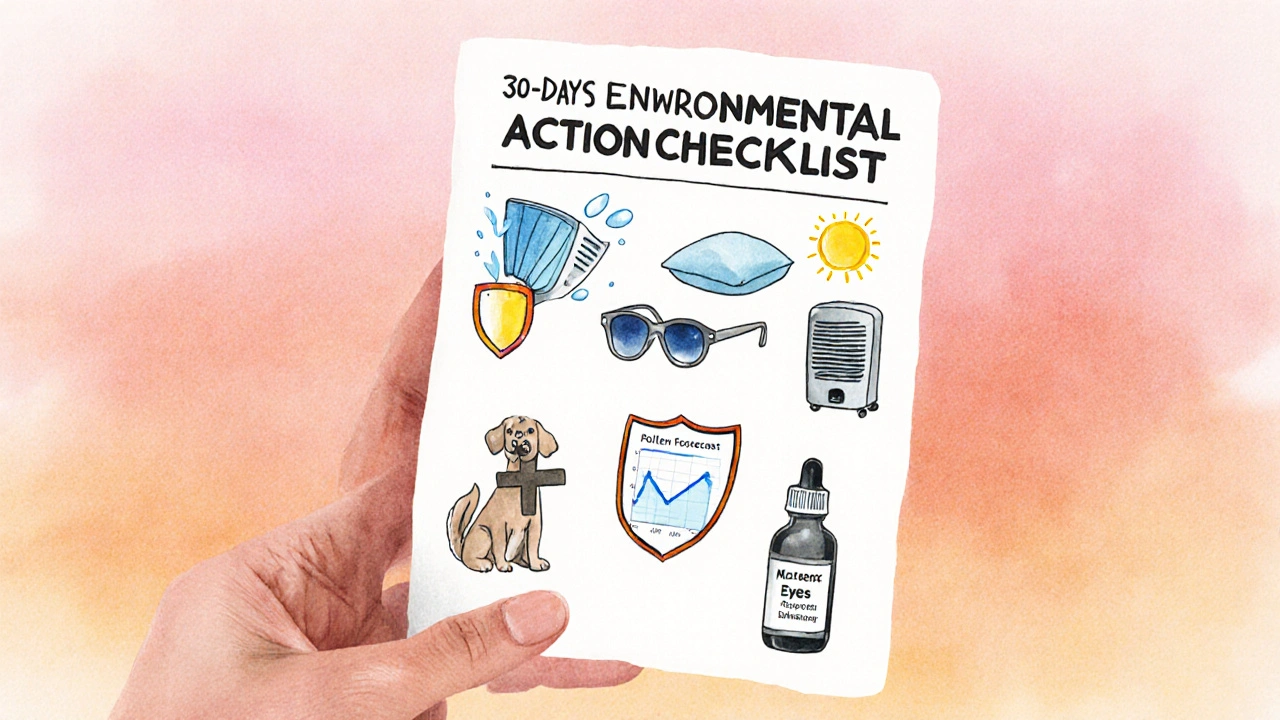How Environmental Modifications Prevent and Manage Allergic Conjunctivitis

Allergic Conjunctivitis Prevention Planner
Complete the profile above to receive personalized recommendations.
30-Day Environmental Plan
- Install HEPA air filter ✓
- Control indoor humidity ✓
- Use allergen-impermeable bedding ✓
- Deep clean with HEPA vacuum ✓
- Create pet-free zones ✓
- Check pollen forecasts ✓
- Wear protective eyewear ✓
- Keep antihistamine drops handy ✓
When the eyes turn red, itchy, and watery, most people chalk it up to a simple irritation. In reality, Allergic conjunctivitis is an inflammation of the conjunctiva caused by an allergic response to airborne particles such as pollen, dust mites, or pet dander and it affects millions worldwide, especially during peak pollen seasons. While eye‑drops can calm the flare‑up, the real key to long‑term relief lies in the spaces we live and work in. Adjusting the surrounding environment-what experts call environmental modifications-can stop symptoms before they start and reduce the need for medication.
Quick Take
- Identify the top indoor and outdoor allergens that trigger your eyes.
- Use HEPA filtration and regular cleaning to cut indoor allergen load.
- Maintain indoor humidity between 40‑60% to discourage dust mites.
- Choose low‑pollen clothing and sunglasses for outdoor activities.
- Combine environmental steps with antihistamine eye drops for best results.
Why the Environment Matters
Allergic conjunctivitis is essentially an over‑reaction of the ocular immune system. When an allergen contacts the eye surface, mast cells release histamine, leading to redness, itching, and tearing. The concentration of allergens in the air directly determines how often this reaction occurs. Outdoor allergens like pollen microscopic grains released by trees, grasses, and weeds during spring, summer, and early fall can reach dozens of grains per cubic meter, while indoor culprits such as dust mites tiny arthropods that thrive in warm, humid bedding and upholstery and pet dander tiny flakes of skin shed by cats, dogs, and other furry animals linger in carpets, curtains, and HVAC systems.
Because the eyes are constantly exposed, any reduction in airborne particles translates into fewer flare‑ups. That's why experts treat environmental control as the first line of defense, much like a firewall for a computer.
Assessing Your Personal Allergen Profile
Before you start swapping out filters, take a quick inventory:
- Timing. Note when symptoms worsen-morning, afternoon, after housekeeping, or during outdoor workouts.
- Location. Do you feel worse at home, at work, or in specific public places?
- Allergen type. If you have a known pollen allergy (e.g., ragweed), prioritize outdoor strategies. If symptoms spike indoors, focus on dust‑mite and dander control.
Keeping a simple diary for two weeks can reveal patterns that guide the next steps.

Indoor Modifications That Really Work
Indoor air quality is the most controllable factor. Here are the proven tactics, backed by research from the American Academy of Allergy, Asthma & Immunology (AAAAI) and recent Canadian health surveys.
1. Upgrade to HEPA Filtration
High‑Efficiency Particulate Air (HEPA) filters capture 99.97% of particles down to 0.3 microns-including pollen, dust‑mite feces, and dander. Install a HEPA air filter a portable or whole‑home unit equipped with a true HEPA filter media in the main living area and bedroom. Replace the filter every 6-12 months, or sooner if you notice reduced airflow.
2. Control Humidity
Dust mites thrive at humidity > 60%. Use a hygrometer to monitor levels and a dehumidifier to keep indoor humidity between 40‑60%. In winter, avoid over‑humidifying with indoor plants; in summer, run the air conditioner with a dry setting.
3. Choose Allergen‑Impermeable Bedding
Encasements for pillows, mattresses, and duvets block dust‑mite allergens. Look for labels that state “99% dust‑mite proof.” Wash bedding weekly in water hotter than 130°F (54°C) to kill remaining mites.
4. Regular, Smart Cleaning
Vacuum with a HEPA‑equipped vacuum cleaner at least twice a week. Damp‑mop hard floors instead of dry sweeping, which can stir up particles. For upholstery, use a handheld HEPA vacuum or steam‑clean once a month.
5. Limit Pet Access
If you have cats or dogs, keep them out of bedrooms and off upholstered furniture. Bathing pets weekly reduces dander, and washing pet bedding weekly helps control the load.
Outdoor Strategies to Cut Pollen Exposure
Even with a flawless indoor environment, pollen can still hit the eyes when you step outside. Follow these habits to keep exposure low:
- Check pollen forecasts. Websites like Environment Canada publish daily pollen counts. Plan outdoor activities for low‑count days (usually after a rainstorm).
- Wear protective eyewear. Wrap‑around sunglasses act as a physical barrier, preventing pollen from reaching the conjunctiva.
- Dress wisely. Long sleeves and pants made of tightly woven fabrics keep pollen from settling on skin and clothing.
- Shower and change. After gardening or sports, shower and change clothes immediately to avoid spreading pollen indoors.
- Wash outdoor gear. Garden tools, helmets, and sports equipment can trap pollen; rinse them before storage.
Combining Environmental Control with Medical Management
Environmental steps lower the allergen load, but occasional flare‑ups still happen. Pairing the two approaches yields the best outcomes.
First‑line medications
Antihistamine eye drops (e.g., olopatadine) block histamine receptors, providing fast relief. Mast‑cell stabilizers (e.g., cromolyn) prevent the cascade if used before exposure. Use them as directed, and keep a small bottle handy for emergencies.
Allergen‑specific immunotherapy
If you’re allergic to a single dominant allergen (like ragweed pollen), consider sublingual or injection immunotherapy. Over 3‑5 years, it can dramatically reduce eye symptoms and even prevent the development of other allergies.
When to see an eye‑care professional
If symptoms persist despite environmental and pharmacologic measures, an ophthalmologist can rule out more serious conditions such as infectious conjunctivitis or blepharitis.
Checklist: Your 30‑Day Environmental Action Plan
- Buy and install a HEPA air filter in your bedroom and living room.
- Place a hygrometer in the most used room; set dehumidifier to keep humidity 40‑60%.
- Purchase allergen‑impermeable pillow and mattress covers.
- Schedule a deep‑cleaning day: vacuum all carpeted areas with a HEPA vacuum, mop hard floors, steam‑clean upholstery.
- Create a pet‑free zone in each bedroom; wash pet bedding weekly.
- Check the local pollen forecast each morning; plan outdoor tasks for low‑count days.
- Buy a pair of wrap‑around sunglasses and wear them during any outdoor activity.
- Keep a bottle of antihistamine eye drops on your nightstand and in your bag.
After 30 days, revisit your symptom diary. You should see a noticeable dip in both frequency and severity.
| Strategy | Indoor | Outdoor |
|---|---|---|
| Air filtration | HEPA units in living spaces | Portable air purifiers for tents or cabins |
| Humidity control | Dehumidifier or humidifier to maintain 40‑60% | Avoid high‑humidity outdoor activities during peak pollen |
| Surface cleaning | HEPA vacuum, damp mopping, allergen‑impermeable bedding | Shower and change clothes after exposure |
| Physical barriers | Allergen-proof window screens | Wrap‑around sunglasses, long sleeves |
| Pet management | Pet‑free bedrooms, regular bathing | Keep pets indoors during high‑pollen days |

Frequently Asked Questions
How long does it take for indoor changes to reduce eye allergy symptoms?
Most people notice a drop in symptoms within 1‑2 weeks of adding a HEPA filter and controlling humidity. Full benefit often appears after 3‑4 weeks as dust‑mite populations decline.
Can I rely only on environmental steps and skip eye drops?
If you have mild seasonal symptoms, rigorous environmental control may be enough. However, most patients find a combination-environmental control plus occasional antihistamine drops-offers the most consistent relief.
Are there any allergens that cannot be controlled at home?
Outdoor pollen and mold spores are impossible to eliminate completely. The goal is to reduce indoor buildup and limit exposure when you’re outside, using the strategies outlined above.
What humidity level is safest for both dust mites and eye health?
Maintain indoor relative humidity between 40% and 60%. Below 40% can irritate the ocular surface, while above 60% encourages dust‑mite growth.
Do I need a special eye mask at night?
A breathable, hypoallergenic eye mask can help keep dust away while you sleep, especially if you have severe indoor allergies. Choose masks made of cotton or silk without synthetic fibers.
Honestly, all those fancy HEPA filters are just a marketing gimmick and wont actually stop pollen from getting into your eyes.
While environmental steps can seem daunting, starting with a single change-such as adding a HEPA filter to your bedroom-often yields noticeable relief within a couple of weeks.
It is imperative to maintain indoor relative humidity between 40 % and 60 %, thereby inhibiting dust‑mite proliferation while preserving ocular surface moisture.
Implementing a nightly routine of showering and changing clothes after outdoor activities can dramatically reduce pollen deposition on bedding.
Buy allergen‑proof pillow covers now 😌
Consider installing a true‑HEPA air purifier; replace its filter every six months; clean it regularly; and monitor indoor humidity with a reliable hygrometer!
Environmental modifications constitute the cornerstone of prophylactic management for allergic conjunctivitis, as they directly attenuate the concentration of airborne allergens to which the ocular surface is exposed. By systematically reducing indoor allergen load, patients experience a measurable decline in symptom frequency and severity. A HEPA filtration system captures particulate matter as small as 0.3 microns, encompassing pollen grains, dust‑mite feces, and pet dander. Regular replacement of the filter ensures sustained efficiency, preventing the re‑circulation of trapped particles. Maintaining indoor relative humidity within the 40‑60 % window disrupts the life cycle of dust mites, which require higher moisture levels to thrive. Allergen‑impermeable bedding barriers act as a physical shield, drastically lowering the exposure to dust‑mite allergens during sleep, a period of prolonged ocular contact. Consistent use of a HEPA‑equipped vacuum eliminates settled dust from carpets and upholstery, further curbing allergen reservoirs. Damp‑mopping hard floors prevents the aerosolization of fine particles that typically occurs with dry sweeping. For pet owners, restricting animal access to sleeping areas and instituting weekly baths substantially reduces dander accumulation. Outdoor strategies, such as consulting daily pollen forecasts, empower individuals to plan activities on low‑pollen days, thereby minimizing exposure. Protective eyewear, particularly wrap‑around sunglasses, creates a barrier that deflects pollen before it can settle on the conjunctiva. Changing into fresh clothing and showering after outdoor exposure removes residual pollen from skin and hair, preventing its transfer to indoor environments. Washing gardening tools and sports equipment eliminates trapped spores, further reducing re‑introduction of allergens. Combining these environmental tactics with pharmacologic agents, like antihistamine eye drops, yields synergistic relief that often surpasses the efficacy of either approach alone. Over a period of thirty days, diligent adherence to the outlined plan typically results in a substantive reduction of ocular inflammation, as evidenced by patient‑reported symptom diaries. Ultimately, the integration of environmental control with appropriate medical therapy offers a comprehensive, sustainable solution for individuals suffering from allergic conjunctivitis.
Yo, i swear my eyes were like fireworks every spring till i got that HEPA thingy and now it's chill, like the allergens just vanished into thin air!
Deploying an integrated HVAC filtration matrix calibrated to MERV‑13 specifications, coupled with a dehumidification subsystem operating at a setpoint of 45 % RH, constitutes an evidence‑based protocol for attenuating aeroallergen load in clinical practice.
Wow-what a transformation-by simply swapping out standard filters for true‑HEPA units, you can dramatically slash particulate intrusion; it’s essentially a breath of fresh, allergen‑free air! 🌬️
While the mainstream narrative glorifies indoor air purification as a panacea for ocular allergies, one must critically examine the underlying assumptions, for the efficacy of HEPA filters can be compromised by improper maintenance, suboptimal placement, and the inevitable re‑aerosolization of captured particles during filter changes; furthermore, an over‑reliance on technological solutions may inadvertently discourage patients from adopting more foundational lifestyle adjustments, such as regular laundering of bedding, diligent humidity control, and consistent pet grooming-a holistic approach that, when properly executed, can yield comparable if not superior outcomes without the recurring financial outlay associated with premium filtration devices.
Stay hopeful-every small step, from sealing windows to using protective glasses, adds up to big relief for your eyes.
Imagine waking up, eyes crystal clear, no itchy clouds, all because you dared to battle the invisible pollen army with a simple filter and a splash of eye drops.